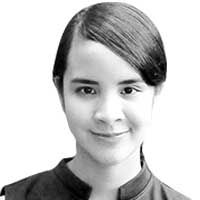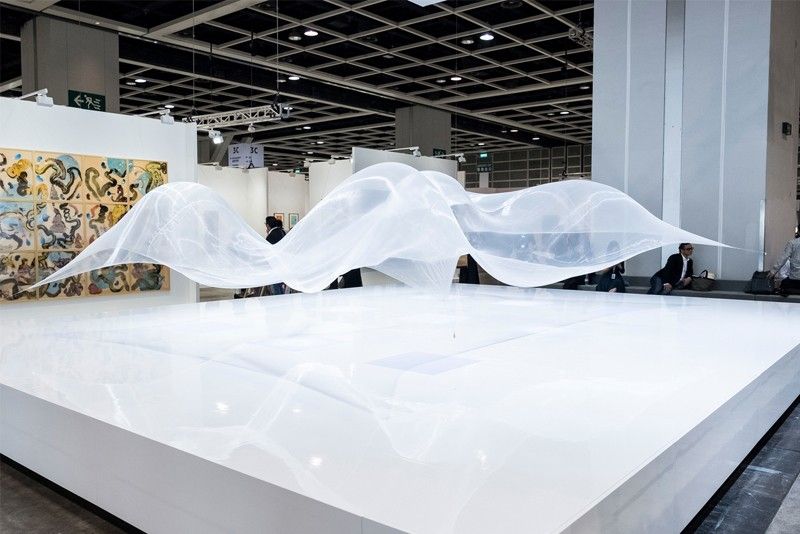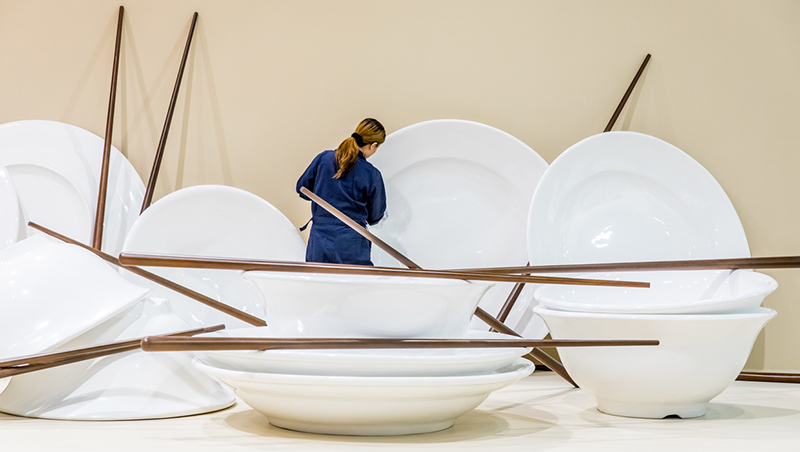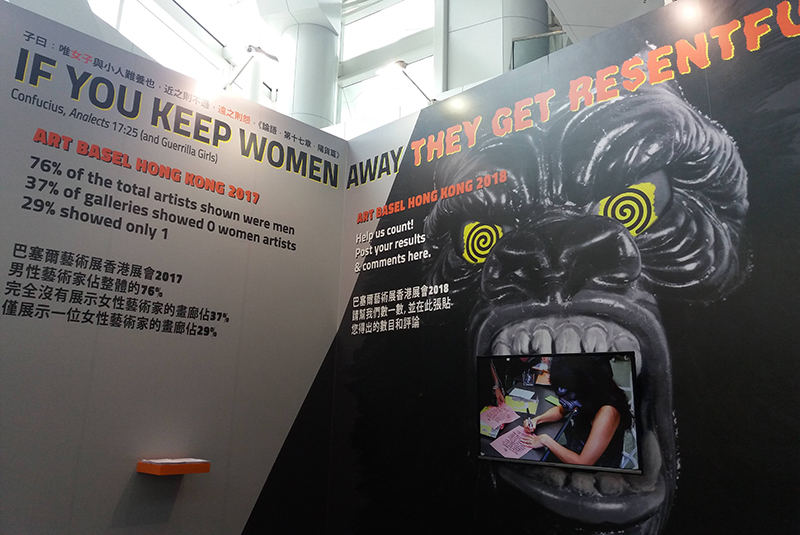From Frog King to Guerrilla Girls: The art world heads east


Art Basel’s ‘Encounters’ sector, inviting slow meditation while evoking themes of movement, seemed to provide a counter-metaphor to Hong Kong’s rapid currents, where all else — cabs, capital, sales — appeared to move at lightning speed.
Hanging above the heads of some 70,000 fairgoers at this year’s Art Basel Hong Kong were farmers’ hand-forged blades forming the shape of angel’s wings. There was a sense of suspense in watching the slow and silent motion of knives as they sliced the air above. Attached on brass rods were sacks of rice that countered the weapons’ weight. As the adage goes, it’s a delicate balance.
“Left Wing Project” was done by Brisbane-based Filipino husband-and-wife artist tandem Isabel and Alfredo Aquilizan and was one of the 12 installations in Art Basel Hong Kong’s “Encounters” sector.

“Refresh, Sacrifice, New Hygiene, Infection, Clean, Robot, Air, Housekeeping, www.agentbong.com, Cigarette, Dyson, Modern People” by Chou Yu Cheng of Edouard Malingue Gallery at the “Encounters” section (Photo courtesy of Art Basel)
“You began speaking with farmers and blacksmiths about the materials that we’re making extinct, traditional forms of manufacture and labor,” said “Encounters” curator Alexie Glass-Kantor in a talk with the artists. “(The work speaks) about inequitable distribution of resources, that nothing stays stable in one form, that when things accelerate beyond the capacity of a community or a society to evolve, then profound inequity occurs.”
Right across the Aquilizans’ show of knives was Shinji Ohmaki’s amorphous cloth, reacting to the forces of air and heat. In the absence of contact, both works hinted at an unseen social contract: the way that the heat of every visitors’ moving body affected the rise and swell of Ohmaki’s work, just as how — and this was how Glass-Kantor drew out the parallelism — the nuclear reactors in Fukushima erupted after the tsunami, responding to the earth’s collective motions.
Art Basel’s “Encounters” sector, inviting slow meditation while evoking themes of movement, seemed to provide a counter-metaphor to Hong Kong’s rapid currents, where all else — cabs, capital, sales — appeared to move at lightning speed.
The fair opened with a private collectors’ preview last March 27 and ran until March 31 at the Hong Kong Convention and Exhibition Center. With 248 galleries on its sixth iteration, Art Basel Hong Kong has been recognized as the premiere art event in Asia.

“Gana (self )” by Nyapanyapa Yunupingu of Roslyn Oxley9 (Photo courtesy of Art Basel)
In the middle of a growing economy, where does the Philippines then stand? Four galleries from Manila established their presence at the fair. Art Informal, for instance, made its foray into “Galleries,” the fair’s main sector. On view were the works of Zean Cabangis, who was last year’s highlight; Alvin Zafra, who was shortlisted for the fair’s BMW Art Journey in 2016; and young artist Ian Fabro whose large-scale works attracted much attention from this year’s crop of collectors.
Also in the “Galleries” sector, bright flares flooded 1335 Mabini as it exhibited the work of Poklong Anading. Flashes of light turned his subjects into anonymous faceless figures (some of them are actually well-known Filipino artists in their younger days). Also at the booth were works of Kiri Dalena, Hong Soun, and Santiago Giralda.
Silverlens similarly presented works across varying mediums: from the brick paintings of Maria Taniguchi, the kinetic sculptural installation of Gabriel Barredo, to the quiet depictions of fisher folks’ eyes by Gregory Halili.
Exploring notions of the body and domestic space — while literally lying eyes closed in a wooden coffin — is Danish-Filipino performance artist Lilibeth Cuenca Rasmussen, presented by the Drawing Room.

Ai Weiwei’s show at Tang Contemporary Art
The fair was never wanting in performance art. If a man elaborately dressed in black, white, and red was once again seen staging strange antics, it’s because Chinese artist Frog King Kwok recreated his calligraphy shop-slash-performance booth from 1992. One of the “Kabinett” sector’s highlights, its commentary on shopping-mall culture found new echoes in today’s hyper-consumerist atmosphere.
“Kabinett” likewise displayed the polymorphous figures of Wifredo Lam while more modern figures were clustered in another space — from Picasso’s cubist forms to the pop-inflected works of Baj, Gnoli, and Raysse — presenting ways we’ve viewed and reimagined the human body across time.
Since the frenzied screens of Nam June Paik, video art found more ambitious incarnations: from Anish Kapoor’s virtual reality installations, to Masayuki Kawai’s fluid color fields made from interlocking cables, like the nervous system gone haywire.
Works by Michael Borremans, Damien Hirst, Mark Ryden, Andy Warhol, and Jeff Koons were also in attendance. If the fair did host an unfair majority of males, the anonymous feminist collective Guerrilla Girls who finally landed in Hong Kong deployed statistics on the underrepresentation of women at Art Basel. One wonders, though, how much of the men tallied represented queer identity, which was something that Sydney-based artist Ramesh Mario Nithiyendran championed when he made “Mud Men” for “Encounters.”
It may be nothing new that gags and gimmicks are routinely staged at fairs, but this year at the “Discoveries” sector, A.M. Space set down an actual DNA testing booth, attempting a bold conceptual feat amid the market’s often-absurdist feast.

Guerrilla Girls booth at Art Basel
The show of course didn’t end at Art Basel. Some distances from the exhibition center, the weeklong event Art Central also coincided with the fair. On show were the works of Veronica Pee, Luis Santos, and Pinky Ibarra Urmaza at Vinyl on Vinyl, and of Alfredo Esquillo Jr. at J Studio.
Ai Wei Wei’s show also opened on the eve of Art Basel Hong Kong’s first collector’s preview, pulling international visitors into the recently established H Queen’s building. The 24-storey property was strategically designed to accommodate more art shows, a seductive draw for blue-chip galleries waiting to set down roots here in Asia.
If there may well be a boom, Hong Kong asserts: It’s well equipped to sustain the movement. The art economy may yet still hang on a delicate balance, but it’s one that this growing capital knows how to carefully orchestrate.



















